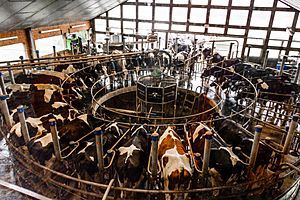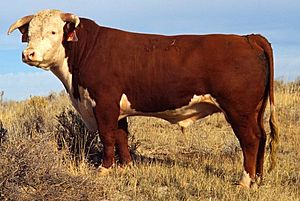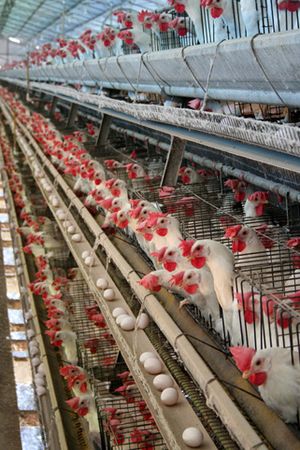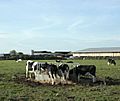Animal husbandry facts for kids
Animal husbandry is all about taking care of and breeding animals, especially farm animals. People have been doing this for a very, very long time. It's even older than growing crops!
In many rural areas, families teach their children how to care for their animals. Organizations like 4-H in the United States also teach young people how to raise and look after farm animals.
Some people who work in animal husbandry focus on making sure the animals are healthy and happy. Others try to raise animals in a way that costs the least amount of money.
Animal husbandry includes taming animals to get products like milk, meat, wool, and leather. It also involves using animals for things like transportation.
Here are some examples of animal husbandry:
- Beekeeping (raising bees)
- Dog breeding (raising dogs)
- Farming (general farm animal care)
- Horse breeding (raising horses)
- Pig farming (raising pigs)
- Raising cattle (cows)
- Sheep farming (raising sheep)
- Dairy farming (raising animals for milk)
Contents
Branches of Animal Husbandry
Dairy Farming
Dairy farming is a part of animal husbandry where animals are raised mainly for their milk. The cow is the most common animal used for milk around the world. People use cow's milk to drink and to make products like cheese and yogurt.
Other animals that give milk include sheep, goats, camels, buffaloes, yaks, reindeer, horses, and donkeys. In the past, cows lived in small groups on family farms. They ate grass in fields and were fed hay in winter. Today, many cows live in larger groups on bigger farms. They often eat silage, which is fermented feed.
Raising Animals for Meat
Many animals are raised to provide meat for people to eat. Meat, especially from farm animals, is a very important source of protein for people all over the world.
Cows usually have one calf each year, and it takes more than a year for the calf to grow big enough for meat. Sheep and goats often have two babies at a time. These young animals are usually ready for meat in less than a year. Pigs can have many piglets, sometimes up to 11, several times a year.
Other animals raised for meat in different parts of the world include horses, donkeys, deer, buffalo, llamas, alpacas, guanacos, and vicunas.
Poultry Farming
Poultry includes all the birds that humans have tamed. These birds are kept for their eggs and for their meat. Common poultry birds are chickens, turkeys, geese, and ducks.
Chickens are the most common birds raised for eggs around the world. There are different ways to keep poultry. In "free-range" systems, birds can walk around freely during the day. At night, they are kept in barns to stay safe. In "semi-intensive" systems, birds live in barns with perches and bedding, and they have some space to move. In "intensive" systems, birds are kept in cages.
Images for kids
-
Cattle feedlot in Colorado, United States.
-
Milking cattle in ancient Egypt.
-
The Lincoln Longwool breed was improved by Robert Bakewell in the 18th century.
-
Herdwick sheep in a large hill farming system in the Lake District, England.
-
Pigs in an intensive system in the Midwestern United States.
-
Cattle around an outdoor feeder.
-
Cattle feed pellets made from pressed linseed.
-
Freshwater fish farming in France.
-
Crickets being raised for human consumption in Thailand.
-
Opening of the budget; – or – John Bull giving his breeches to save his bacon by James Gillray (d. 1815).
-
Dressed pigs in Beatrix Potter's 1913 The Tale of Pigling Bland.
See also
 In Spanish: Ganadería para niños
In Spanish: Ganadería para niños


















